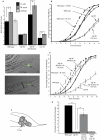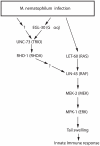Behavioral and immune responses to infection require Gαq- RhoA signaling in C. elegans
- PMID: 22359503
- PMCID: PMC3280986
- DOI: 10.1371/journal.ppat.1002530
Behavioral and immune responses to infection require Gαq- RhoA signaling in C. elegans
Abstract
Following pathogen infection the hosts' nervous and immune systems react with coordinated responses to the danger. A key question is how the neuronal and immune responses to pathogens are coordinated, are there common signaling pathways used by both responses? Using C. elegans we show that infection by pathogenic strains of M. nematophilum, but not exposure to avirulent strains, triggers behavioral and immune responses both of which require a conserved Gαq-RhoGEF Trio-Rho signaling pathway. Upon infection signaling by the Gαq pathway within cholinergic motorneurons is necessary and sufficient to increase release of the neurotransmitter acetylcholine and increase locomotion rates and these behavioral changes result in C. elegans leaving lawns of M. nematophilum. In the immune response to infection signaling by the Gαq pathway within rectal epithelial cells is necessary and sufficient to cause changes in cell morphology resulting in tail swelling that limits the infection. These Gαq mediated behavioral and immune responses to infection are separate, act in a cell autonomous fashion and activation of this pathway in the appropriate cells can trigger these responses in the absence of infection. Within the rectal epithelium the Gαq signaling pathway cooperates with a Ras signaling pathway to activate a Raf-ERK-MAPK pathway to trigger the cell morphology changes, whereas in motorneurons Gαq signaling triggers behavioral responses independent of Ras signaling. Thus, a conserved Gαq pathway cooperates with cell specific factors in the nervous and immune systems to produce appropriate responses to pathogen. Thus, our data suggests that ligands for Gq coupled receptors are likely to be part of the signals generated in response to M. nematophilum infection.
Conflict of interest statement
The authors have declared that no competing interests exist.
Figures







Similar articles
-
Modulation of Gq-Rho Signaling by the ERK MAPK Pathway Controls Locomotion in Caenorhabditis elegans.Genetics. 2018 Jun;209(2):523-535. doi: 10.1534/genetics.118.300977. Epub 2018 Apr 3. Genetics. 2018. PMID: 29615470 Free PMC article.
-
Trio's Rho-specific GEF domain is the missing Galpha q effector in C. elegans.Genes Dev. 2007 Nov 1;21(21):2731-46. doi: 10.1101/gad.1592007. Epub 2007 Oct 17. Genes Dev. 2007. PMID: 17942708 Free PMC article.
-
A Gαq-Ca²⁺ signaling pathway promotes actin-mediated epidermal wound closure in C. elegans.Curr Biol. 2011 Dec 6;21(23):1960-7. doi: 10.1016/j.cub.2011.10.050. Epub 2011 Nov 17. Curr Biol. 2011. PMID: 22100061 Free PMC article.
-
Gαq signalling: the new and the old.Cell Signal. 2014 May;26(5):833-48. doi: 10.1016/j.cellsig.2014.01.010. Epub 2014 Jan 17. Cell Signal. 2014. PMID: 24440667 Review.
-
Neurotransmitter signaling through heterotrimeric G proteins: insights from studies in C. elegans.WormBook. 2018 Dec 11;2018:1-52. doi: 10.1895/wormbook.1.75.2. WormBook. 2018. PMID: 26937633 Free PMC article. Review.
Cited by
-
From head to tail it's a 2 way street for neuro-immune communication.Worm. 2014 Oct 30;3(3):e959425. doi: 10.4161/21624046.2014.959425. eCollection 2014 Jul-Sep. Worm. 2014. PMID: 26430547 Free PMC article.
-
Detection of Pathogens and Regulation of Immunity by the Caenorhabditis elegans Nervous System.mBio. 2021 Mar 30;12(2):e02301-20. doi: 10.1128/mBio.02301-20. mBio. 2021. PMID: 33785621 Free PMC article. Review.
-
Canonical RTK-Ras-ERK signaling and related alternative pathways.WormBook. 2013 Jul 11:1-38. doi: 10.1895/wormbook.1.80.2. WormBook. 2013. PMID: 23908058 Free PMC article. Review.
-
Identification of a Conserved, Orphan G Protein-Coupled Receptor Required for Efficient Pathogen Clearance in Caenorhabditis elegans.Infect Immun. 2019 Mar 25;87(4):e00034-19. doi: 10.1128/IAI.00034-19. Print 2019 Apr. Infect Immun. 2019. PMID: 30692178 Free PMC article.
-
Non-Mammalian Models for Understanding Neurological Defects in RASopathies.Biomedicines. 2024 Apr 10;12(4):841. doi: 10.3390/biomedicines12040841. Biomedicines. 2024. PMID: 38672195 Free PMC article. Review.
References
-
- Beutler B. Innate immunity: an overview. Mol Immunol. 2004;40:845–859. - PubMed
-
- Beutler B, Crozat K, Koziol JA, Georgel P. Genetic dissection of innate immunity to infection: the mouse cytomegalovirus model. Curr Opin Immunol. 2005;17:36–43. - PubMed
-
- Boman HG. Innate immunity and the normal microflora. Immunol Rev. 2000;173:5–16. - PubMed
Publication types
MeSH terms
Substances
Grants and funding
LinkOut - more resources
Full Text Sources
Research Materials
Miscellaneous

